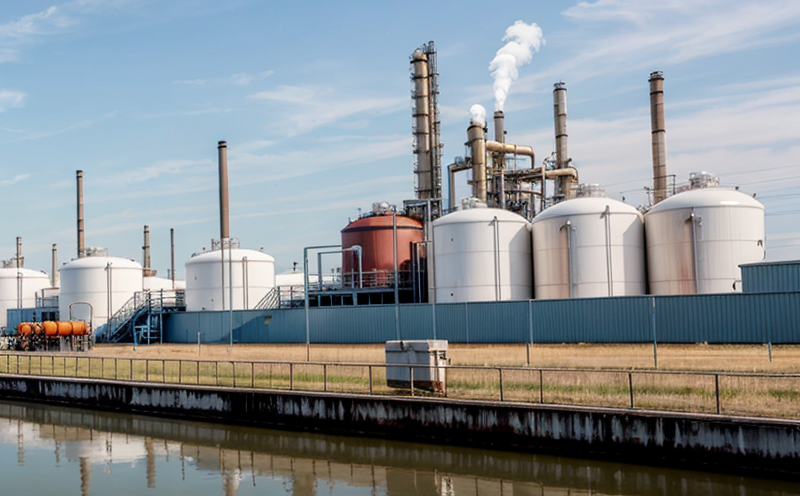ASTM D1121 Reserve Alkalinity Safety Testing of Coolants
The ASTM D1121 reserve alkalinity safety test is a critical procedure used to evaluate the ability of coolants to neutralize acidic contaminants. This testing is essential in industries where industrial chemicals and coolants are crucial for manufacturing processes, such as automotive, aerospace, and electronics. By ensuring that coolants have sufficient reserve alkalinity, manufacturers can prevent equipment corrosion and extend the life of their machinery.
The reserve alkalinity test involves measuring the amount of alkali that remains in a coolant after it has been exposed to acidic contaminants. This is determined by titrating a sample with standardized hydrochloric acid until the pH reaches 8.2 or 9.0, depending on the specific industry requirements. The difference between the initial and final volumes of acid consumed provides a quantitative measure of the reserve alkalinity.
The importance of this test cannot be overstated, especially in environments where coolants are subject to high temperatures and corrosive conditions. By conducting ASTM D1121 testing, quality managers and compliance officers can ensure that their chosen coolants meet or exceed industry standards for safety and performance. This is particularly important given the increasing scrutiny from regulatory bodies regarding chemical usage in industrial settings.
For R&D engineers, this test offers a valuable tool to identify optimal coolant formulations that provide both excellent reserve alkalinity and other desired properties such as thermal conductivity and lubricity. In procurement, ensuring suppliers adhere to these standards can significantly reduce the risk of equipment failure due to corrosion.
The testing process itself is straightforward but requires precision and accuracy. Samples must be collected from representative points within the cooling system, avoiding any contaminated or stagnant areas. Once collected, samples are analyzed using standardized methods that ensure consistency and reliability across different batches and suppliers.
By implementing ASTM D1121 reserve alkalinity testing as part of their quality control protocols, companies can make informed decisions about chemical selection, ensuring not only compliance with regulatory requirements but also enhancing the overall efficiency and longevity of their operations. This proactive approach to coolant management helps protect valuable assets and contributes to sustainable manufacturing practices.
For industries where equipment downtime is costly, the ability to predict and prevent issues through regular reserve alkalinity testing cannot be overstated. It allows for timely intervention if reserve levels fall below acceptable thresholds, thereby minimizing the risk of unexpected failures and associated costs.
In summary, ASTM D1121 reserve alkalinity safety testing is a vital component in safeguarding industrial equipment from corrosion caused by acidic contaminants. Its precision, reliability, and industry-wide recognition make it an indispensable tool for quality managers, compliance officers, R&D engineers, and procurement teams alike. By incorporating this test into their workflows, these professionals can ensure the highest standards of safety and performance across all aspects of chemical use in industrial settings.
Why It Matters
The reserve alkalinity testing outlined by ASTM D1121 is essential for ensuring the longevity and reliability of machinery used in various industries. By measuring the alkali content remaining after exposure to acidic contaminants, this test provides critical insights into a coolant's ability to neutralize these harmful substances.
- Maintains equipment integrity
- Prevents costly downtime due to corrosion
- Safeguards against environmental damage caused by acidic residues
- Ensures compliance with industry-specific standards and regulations
- Facilitates the selection of optimal coolant formulations that meet performance criteria
The results of this test are particularly important for industries where machinery operates under extreme conditions, such as high temperatures or corrosive atmospheres. By prioritizing reserve alkalinity testing, companies can enhance their operational efficiency and reduce maintenance costs.
Why Choose This Test
- Affirmative Compliance: Ensures compliance with international standards such as ASTM D1121, which is widely recognized in the industry for its rigorous testing protocols.
- Reliable Results: Provides consistent and accurate measurements of reserve alkalinity, crucial for maintaining equipment integrity.
- Cost-Effective: Prevents costly downtime by identifying potential issues early on, allowing for timely interventions.
- Expertise: Leverages the expertise of our accredited laboratory team to ensure the highest standards in testing and analysis.
The ASTM D1121 reserve alkalinity safety test is not just a requirement; it's an investment in long-term equipment reliability. By choosing this test, companies can demonstrate their commitment to quality control and environmental responsibility.
Customer Impact and Satisfaction
By implementing ASTM D1121 reserve alkalinity safety testing into their operations, customers benefit from extended equipment life, reduced maintenance costs, and enhanced overall reliability. This proactive approach ensures that machinery remains in optimal condition, minimizing the risk of unexpected failures.
Our comprehensive testing services not only meet but exceed industry expectations, providing peace of mind to quality managers, compliance officers, R&D engineers, and procurement teams alike. Customer satisfaction is paramount, and we strive to deliver results that are both accurate and actionable, enabling informed decision-making processes.
The precise nature of our reserve alkalinity testing ensures that the information provided is reliable and can be trusted for critical decisions regarding chemical selection and usage. This commitment to excellence has earned us a reputation as a leading provider in industrial chemical safety testing.





